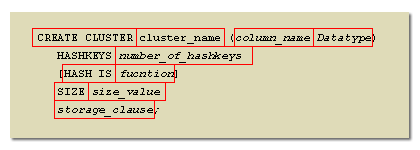Creating Hash Clusters
A hash cluster is created using a CREATE CLUSTER statement, but you specify a HASHKEYS clause. The following example contains a statement to create a cluster named trial_cluster that stores the trial table,
clustered by the trialno column (the cluster key); and another statement creating a table in the cluster.
CREATE CLUSTER trial_cluster (trialno NUMBER(5,0)) TABLESPACE users STORAGE (INITIAL 250K NEXT 50K MINEXTENTS 1 MAXEXTENTS 3 PCTINCREASE 0) HASH IS trialno HASHKEYS 150; CREATE TABLE trial ( trialno NUMBER(5,0) PRIMARY KEY, ...) CLUSTER trial_cluster (trialno);
As with index clusters, the key of a hash cluster can be a single column or a composite key (multiple column key). In this example, it is a single column.
The HASHKEYS value, in this case 150, specifies and limits the number of unique hash values that can be generated by the hash function used by the cluster.
The database rounds the number specified to the nearest prime number. If no HASH IS clause is specified, the database uses an internal hash function. If the cluster key is already a unique identifier that is uniformly distributed over its range, you can bypass the internal hash function and specify the cluster key as the hash value, as is the case in the preceding example. You can also use the HASH IS clause to specify a user-defined hash function. You cannot create a cluster index on a hash cluster, and you need not create an index on a hash cluster key.
The database rounds the number specified to the nearest prime number. If no HASH IS clause is specified, the database uses an internal hash function. If the cluster key is already a unique identifier that is uniformly distributed over its range, you can bypass the internal hash function and specify the cluster key as the hash value, as is the case in the preceding example. You can also use the HASH IS clause to specify a user-defined hash function. You cannot create a cluster index on a hash cluster, and you need not create an index on a hash cluster key.
Creating a hash cluster

CREATE CLUSTER cluster_name (column_name Datatype) HASHKEYS number_of_hashkeys [HASH IS function] SIZE size_value storage_clause